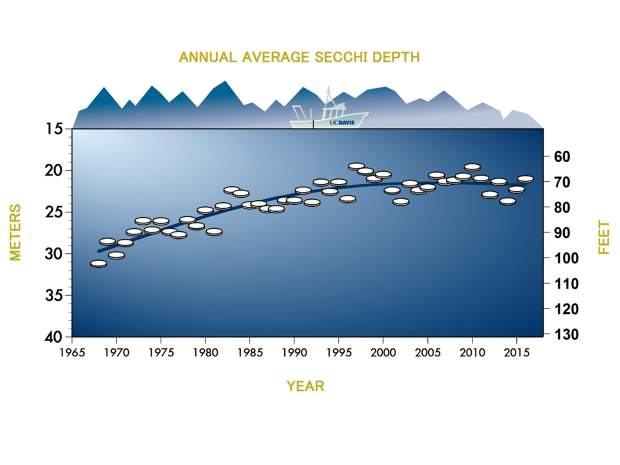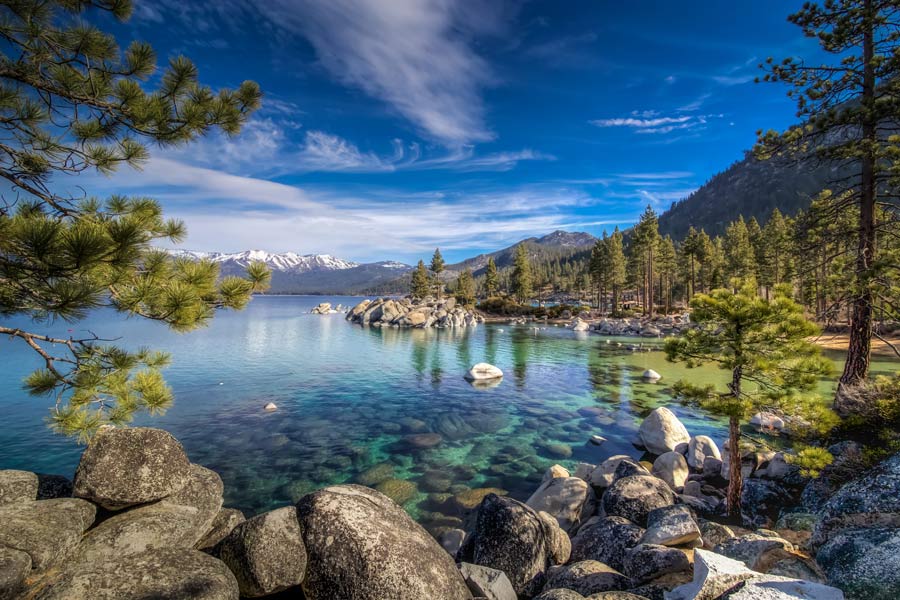Lake Tahoe clarity declines 4 feet
UC Davis

Clarity levels at Lake Tahoe in 2016 increased in winter and decreased in summer in 2016. The summer values were due to the continuing effects of climate change, according to researchers at the University of California, Davis. The summer declines were so large that they outweighed the improving winter clarity.
Data released today by the UC Davis Tahoe Environmental Research Center (TERC) and the Tahoe Regional Planning Agency reported the average annual clarity level for 2016 at 69.2 feet, which is a 3.9-foot decrease from the previous year, but still more than 5 feet greater than the lowest recorded average of 64.1 feet in 1997.
The 2016 clarity level is the average of 30 individual readings taken from January through December 2016. The highest value recorded in 2016 was an astounding 95.1 feet on Jan. 25, and the lowest was 44.3 feet on June 7.
Despite 2016’s summer decline, the data record indicates that Lake Tahoe’s long-term trend of clarity decline ended about 15 years ago. Since then, clarity has hovered around a value of 71 feet but with sizable inter-annual and seasonal variability.
Climate impacting clarity
The decline in 2016 is the second year in a row in which the effects of a changing climate have impacted clarity. However, the causes of the decline in each year were different.
In 2015, clarity was reduced by relatively warm layers of turbid water entering near the lake surface. In 2016 the clarity was reduced by the early onset of spring, favoring the growth of light-blocking blooms of very small algal cells.
“Lake managers and researchers must continue to work together to better understand the impacts that continued climate change will have at Lake Tahoe, and look for new solutions to mitigate those impacts as we work to restore lake clarity,” said Geoffrey Schladow, director of the University of California, Davis, Tahoe Environmental Research Center. “Lake Tahoe has an international reputation for collaboration between science and policymakers and in light of these new threats, it’s more important than ever to continue that collaboration.”
Winter clarity highest since 2012
Winter clarity (December 2015 through March 2016) increased by 11.7 feet. The winter average of 83.3 feet was the highest, or clearest, recorded since 2012.
The annual precipitation for 2016 was close to average at 32.1 inches, with about a quarter of the precipitation falling as snow, lower than the long-term trend. Precipitation had little effect on the lake’s clarity, primarily due to stormwater control and watershed restoration projects designed to retain fine particles and nutrients.
Summer clarity down nearly 17 feet
Summer clarity (June through September 2016) fell to 56.4 feet, a 16.7-foot decline over the preceding year. Data indicate that the decline was caused by large increases of Cyclotella, a small diatom. The extremely small size of Cyclotella (5 microns) allows it to scatter light and produces the greatest Secchi depth decline.
Why did Cyclotella bloom in 2016? As the surface of the lake warms, it reduces the natural mixing that keeps all algae suspended. In 2016, the lake water temperature was at record-high levels, and the lake stratified, or separated into layers, at close to the earliest time ever. Data collected for more than 50 years at Lake Tahoe have shown that the lake temperature has increased due to climate change, favoring smaller algal species.
Working together
The Tahoe Regional Planning Agency leads the collaborative Lake Tahoe Environmental Improvement Program, a multijurisdictional partnership to reduce stormwater runoff and repair past damage to the ecosystem.
Over the past two decades, the Environmental Improvement Program has resulted in substantial public and private investment in projects to improve water quality and other environmental indicators at Lake Tahoe. Among the hundreds of measurements the TRPA tracks, mid-lake clarity is a key indicator of whether restoration programs are working.
“The actions TRPA and 50-plus partners have taken to reduce stormwater pollution and restore important natural areas like marshes and wetlands are helping protect and restore Lake Tahoe’s famous water clarity,” said Joanne S. Marchetta, executive director of Tahoe Regional Planning Agency. “Climate change is impacting not only Lake Tahoe’s water quality, but also the health of its forests and its recreation-based economy. TRPA and partners are committed to addressing the threats that climate change poses, and promoting solutions that improve the resiliency of Lake Tahoe’s environment and communities.”
Clarity a key indicator for Tahoe
Water clarity measurements have been taken continuously by UC Davis TERC since 1968, when a white disk, called the Secchi disk, could be seen down to 102.4 feet. It is one of the longest, unbroken clarity records in the world. Secchi depth is the most widely used method of clarity measurement, and the values are consistent with laser-based measurements also taken by TERC researchers.
Improved real-time monitoring instruments, together with sophisticated models of the lake currents that transport contaminants in Lake Tahoe, are helping researchers build a deeper understanding of restoration progress within the entire lake ecosystem.
“Secchi depth is just one indicator of Lake Tahoe’s overall condition,” Schladow said. “Having just come through one of the most extreme droughts on record and a period of unusually rapid warming, this year’s measurements have reinforced our understanding of Lake Tahoe. First, the improvement in winter clarity is evidence that actions being taken are having positive impacts. Second, the decline of summer clarity is reminding us that the impacts of climate change are complex, multifaceted and still evolving.”
Agencies in the Lake Tahoe Basin are working to restore the lake’s famous water clarity to 97.4 feet by 2076. Progress toward that target is measured in five-year averages. While the average clarity in 2016 was 69.2 feet, the current five-year average clarity level is 73.1 feet, surpassing the interim restoration target of 71 feet by 2016.
More information about environmental factors affecting Lake Tahoe will be included in the 2017 State of the Lake Report, expected this summer.
Funding for TERC’s clarity analyses comes from the Tahoe Regional Planning Agency and UC Davis.

Support Local Journalism

Support Local Journalism
Readers around the Lake Tahoe Basin and beyond make the Tahoe Tribune's work possible. Your financial contribution supports our efforts to deliver quality, locally relevant journalism.
Now more than ever, your support is critical to help us keep our community informed about the evolving coronavirus pandemic and the impact it is having locally. Every contribution, however large or small, will make a difference.
Your donation will help us continue to cover COVID-19 and our other vital local news.





